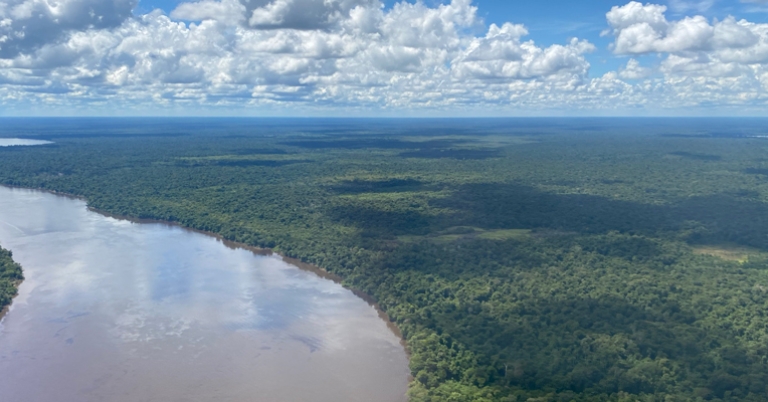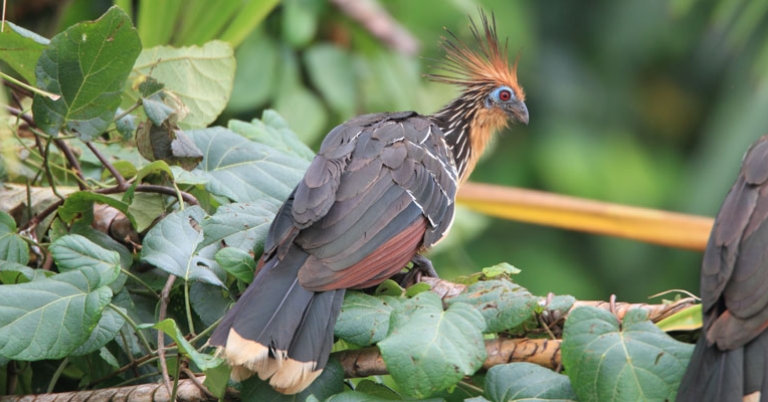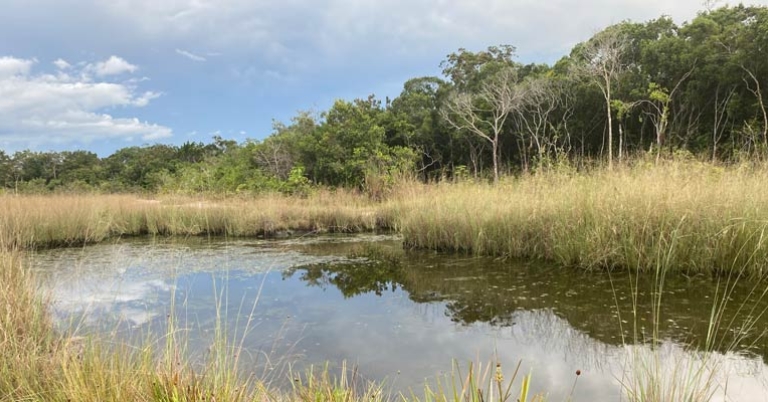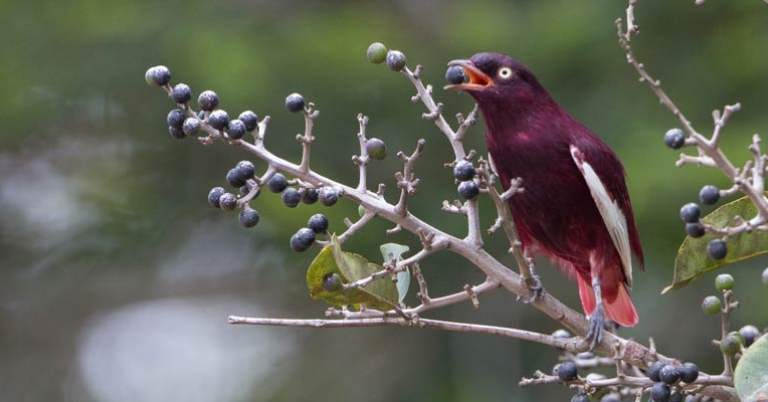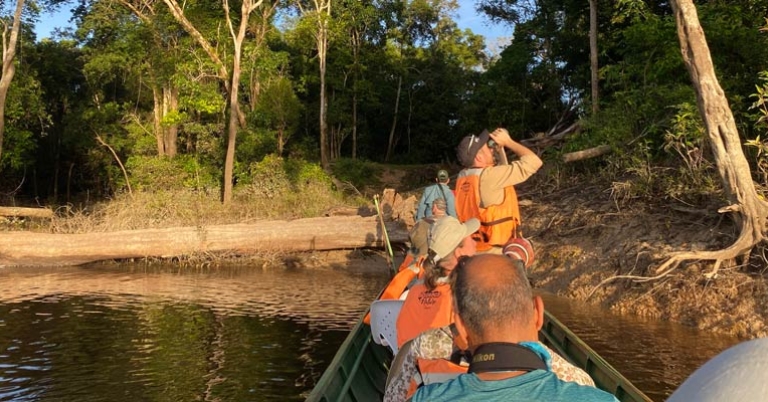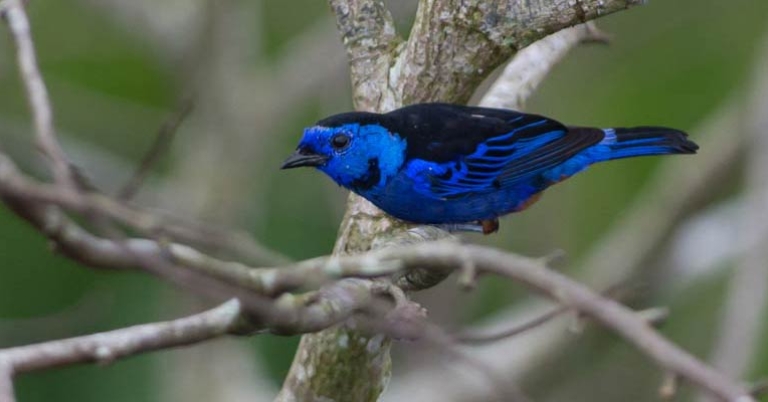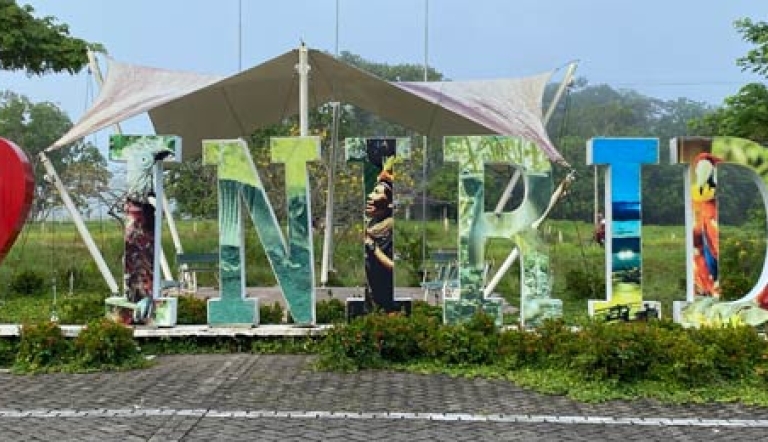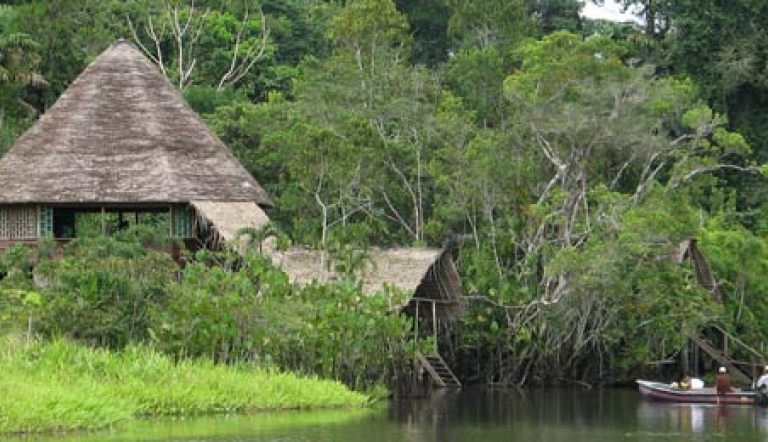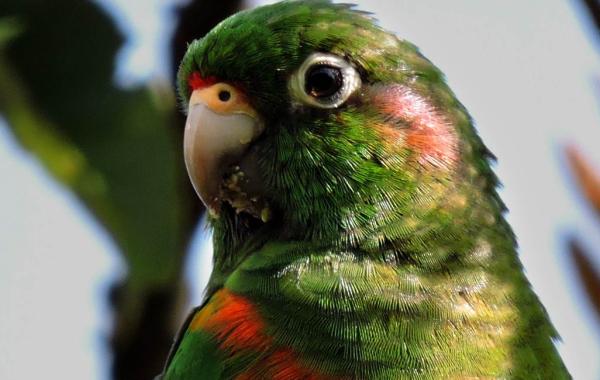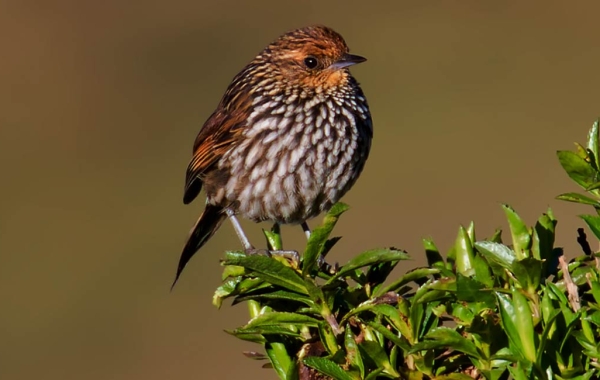Colombia | Birding in the Colombian Amazon and Llanos
About this trip
Venture into the contrasting ecosystems of the Colombian Llanos and Amazon on this 11-day journey to discover the hundreds of bird species that call the Gateway to South America home. Marvel at the complex topography surrounding Villavicencio, where the Andes meet the vast Llanos, and cruise through the Amazonian wetlands around Inírida, with its low forests, rivers and white sand. Learn about the abundant endemic wildlife from local Indigenous communities who are especially enthusiastic about birds and see emblematic species like the Capuchinbird, the Orinoco Softail, and even pink river dolphins and giant otters.
Highlights
- Meet the Indigenous communities of Sabanitas and spot the Capuchinbirds and Bare-necked Fruitcrows that inhabit their trails.
- Visit the best birdwatching spot in Inírida, the Matraca Trail, and see endemic species like the Rose-breasted Chat and the Orinoco Softail.
- Sail up the Inírida River and witness the biodiversity along its shores, with potential sightings of the Tropical Royal Flycatcher, the Wire-tailed Manakin, and many more.
- Explore the Halcón Colorado Natural Reserve from Fundación Proaves, located at the top of the Bavaria Forest, and enjoy stunning views of the Colombian Llanos and rich avifauna.
- Enjoy the chance to see more than 400 bird species around Villavicencio, including the Cundinamarca Antpitta, as this area has become an excellent spot for birdwatching due to the nature of the transitional foothills between the Andes and the savannas of Colombia.
Activity Level 3: Moderate
Participants should be able to ascend or descend 60 stairs consecutively, plus walk for at least 3 hours over some steep slopes, uneven, and potentially slippery surfaces without difficulty. Physical activities typically last for 3 or more hours at a time.
Land Cost
$5,095 - Jul 1, 2025 - Dec 31, 2026
$5,450 - Jan 1 - Dec 31, 2027
Book 8 travelers and 1 group
leader travels for free
What makes us different
Rich content
Service anytime
Top birding guides
Cultural Discovery
Unique Itineraries
Flight arrangements
Daily Itinerary
Print ItineraryBogota
Day 1Inirida
Day 2Inirida
Day 3Inirida
Day 4Inirida
Day 5Inirida
Day 6Villavicencio
Day 7Villavicencio
Day 8Villavicencio
Day 9Bogota
Day 10Depart
Day 11Pricing
Print PricingLand Cost
$5,095 - Jul 1, 2025 - Dec 31, 2026
$5,450 - Jan 1 - Dec 31, 2027
Book 8 travelers and 1 group
leader travels for free
What's Included
- Accommodations with private bathrooms
- Activities and meals as mentioned in itinerary
- Arrival and departure transfers based on individual flight schedules
- Bottled water or water refill station during transfers
- Carbon Offset
- Full time expert birding naturalist guide for duration of program
- Internal flights relevant to itinerary
- Non alcoholic beverage with meals
- Private transportation and driver for the duration of the program
What's Not Included
- International airfare
- Items of personal nature
- Tips
- Travel Insurance
- Trip cancellation coverage
Pricing Details
Prices are valid for travel from Jul 1, 2025 - Dec 31, 2026. Holiday surcharges may apply.
Travel Info
Print Travel InfoEntry & Exit Requirements
U.S. citizens must have a valid passport with at least one blank page to enter Colombia. Passports must be valid for at least the duration of your stay. As this requirement is subject to change at any time without prior notice, it is strongly recommended that passports be valid for at least six months beyond your expected departure date.
A Colombian visa is not required for tourist stays of 90 days or less. Travelers entering Colombia are sometimes asked to present evidence of return or onward travel, usually in the form of a plane ticket.
A Migración Colombia Check-Mig immigration form must be completed within 72 hours of your flight to Colombia and at least 1 hour prior to boarding. You will be required to enter the address of your accommodation (to be provided in your pre-departure documents) and your flight number. The form can be found at https://apps.migracioncolombia.gov.co/pre-registro/en. You will receive a confirmation email that you will need to present upon arrival in Colombia. (You may also be asked to show this confirmation before boarding your flight in the U.S.)
If you are not traveling with a U.S. passport, please check with the Colombian Embassy for the requirements based on your nationality.
Health & Safety
Please consult your physician for guidance on medical issues. Holbrook Travel is not authorized to provide medical information and the following advice should be confirmed with your doctor.
Immunizations
The Centers for Disease Control recommends that all travelers be up-to-date on routine vaccinations such as measles-mumps-rubella (MMR) vaccine, diphtheria-pertussis-tetanus vaccine, varicella (chicken pox) vaccine, and your yearly flu shot, as well as the COVID-19 vaccine, before every trip.
There are no vaccinations required for entry into Colombia, but yellow fever vaccine is required for entry into the Inírida municipality. Please be prepared to present your certificate of yellow fever vaccination upon arrival in Inírida. Currently, those who do not have the vaccination certificate are able to obtain the vaccination for free upon arrival in Inírida at the checkpoint in the César Gaviria Trujillo Airport. However, as this may change in the future, we recommend getting vaccinated before departing for Colombia.
Though not required, the CDC also recommends vaccination against hepatitis A, hepatitis B, and typhoid for most unvaccinated travelers to Colombia.
Please visit cdc.gov/travel or consult your physician for additional information and recommendations based on your individual circumstances.
Malaria
The CDC warns that travelers to Colombia may be at risk for exposure to malaria, especially at elevations below 5,600 feet. Malaria is caused by a parasite found in Anopheles mosquitos, which are active from dusk until dawn. Prevention is twofold: the use of anti-malarial drugs and the prevention of insect bites. Prophylaxis is not required for entry into the country, but if you choose to use an anti-malarial drug, as recommended by the CDC, see your physician for a prescription. To protect against mosquitos, cover exposed skin with lightweight, long-sleeved shirts and pants, consider treating clothes with permethrin, and use an insect repellent containing an active ingredient like DEET or picaridin. Apply sunscreen first, followed by the repellent (preferably 20 minutes later).
Other Insect-borne Illnesses
Other insect-borne illnesses are known to occur in Colombia, including dengue fever, leishmaniasis, Zika virus, and others. Travelers to Colombia should protect themselves against insect bites using the measures described above.
As a precaution, the CDC advises women who are pregnant to consider postponing travel to any area where Zika virus transmission is ongoing.
After spending time outdoors, especially in grassy or wooded areas, the CDC recommends showering and conducting a full-body check for ticks. If you find a tick attached to your skin, safely remove it as soon as possible.
Altitude sickness
Upon arrival at locations of high elevation (above 5,000 feet), shortness of breath and a pounding heart are normal responses to the lack of oxygen in the air. However, for some visitors, these symptoms can deteriorate into altitude sickness. Headache, extreme tiredness, dizziness, nausea, and loss of appetite are standard symptoms. Staying hydrated and well rested is important to adjust to the altitude. Avoiding heavy, fatty foods and alcohol in the days before arriving to altitude can help. Over-the-counter medications are also available to help prevent or alleviate symptoms. It’s advisable to avoid sleep medications, as they can slow breathing and respiration, which aid in getting the blood oxygenated while sleeping. Participants who take blood pressure medications should discuss this with their doctor as the medication can drop pressure too low at times.
SUN EXPOSURE
The effects of the sun can be damaging to the eyes and skin. Spending time outdoors exposes you to the sun’s harmful ultraviolet (UV) rays, even on cloudy days. To protect yourself from the sun, use a broad spectrum sunscreen of at least SPF 15, protect skin with clothing, wear a wide-brimmed hat and sunglasses, and drink plenty of fluids.
Respiratory Illness Protocols
Please review our Respiratory Illness Protocols page, which explains our policy and procedures if you or another traveler should develop symptoms of a respiratory illness during your trip. Your participation in a Holbrook Travel program indicates that you are in agreement with these protocols.
Resources
Print ResourcesPacking Recommendations
Everyone has personal preferences when it comes to packing; for this reason, the information below is offered as a general guide and not a definitive list. You know yourself best: Use your discretion and pack what you think will serve you, based on your personal preferences and specific itinerary.
You may find many of the items below in our Gear Store.
CLOTHING
Casual, comfortable clothing is suitable for most activities. You may wish to bring a slightly nicer outfit or two if your itinerary includes dinners out or more formal activities.
Bring enough clothing suitable for the length of your program. If you prefer to pack light, note that many hotels offer laundry services at additional cost. If you plan to hand-wash items, remember that humidity may delay drying time.
Pack clothing that can be worn in layers to adapt to weather changes throughout the day. The rainy season in the Colombian Amazon is December to May, whereas the rainy season in the city of Villavicencio is March to December, but it can rain at any time in both regions. Clothing that wicks away moisture and dries quickly is recommended.
- A combination of short-sleeved and lightweight, long-sleeved shirts for sun and mosquito protection
- Shorts
- Lightweight, quick-drying long pants for sun and mosquito protection; jeans tend to be uncomfortable in hot and humid conditions, but are fine in the cooler highlands.
- Undergarments
- Sleepwear
- Lightweight jacket or sweater/sweatshirt
- 1-2 bathing suit(s)
- Socks – Bring extra pairs. If your itinerary indicates muddy hikes with rubber boots provided on-site, pack a few pairs of knee socks to prevent blisters.
- Shoes – Consider your specific itinerary when choosing footwear. For most programs, you’ll likely want at least one pair of comfortable, closed-toe walking or hiking shoes suitable for forest hikes and walking over cobblestones or other uneven terrain. Sturdier hiking boots may be appropriate for more rugged itineraries. In addition, many participants opt for a pair of sturdy sport-strap sandals (e.g. Keens, Tevas, or similar) and/or casual flip-flops or sandals. You may also want a pair of aqua socks, reef walkers, or water shoes.
- Lightweight rain jacket, hooded poncho, and/or windbreaker
- Visor or wide-brimmed sun hat
- Bandana, scarf, or Buff-style headwear
Personal Toiletries
Pack toiletries based on your personal preferences and habits. Below are just a few recommendations to keep in mind.
- Shampoo, conditioner, lotion, deodorant/antiperspirant , etc. – If possible, avoid strong fragrances if you are sensitive to insect bites and in consideration of your fellow travelers.
- Soap and washcloth or a small, quick-drying microfiber towel – Washcloths are not standard in all hotels. If you normally use a washcloth, you may wish to bring one from home.
- Hairbrush, comb, hair ties, shower cap. Not all hotel rooms provide a hair dryer, so you may wish to bring one from home.
- Toothbrush and toothpaste
- Razor
- Ear plugs, especially if you are a light sleeper
- Personal hygiene products
- Insect repellent with DEET or picaridin (see note below about treating clothing with permethrin)
- Sunscreen and lip balm with SPF
- Aloe vera gel
- A travel pack of tissues – also useful as napkins or toilet paper if needed
In addition to your personal toiletries, it is useful to pack a small medical kit, which you can easily prepare. Helpful items might include: bandages, antihistamine, a pain reliever, motion sickness medication (if you are prone to it), anti-diarrhea medicine, individually wrapped pre-moistened towelettes and/or hand sanitizer, antibiotic ointment, anti-fungal cream, moleskin for blisters, eye drops, tweezers, a mini sewing kit, and an extra pair of disposable contact lenses or eyeglasses if you wear them.
Days before you leave home, you may wish to consider spraying any clothing, socks, and shoes that will be worn in lowland, tropical sites with permethrin, an anti-parasite medication, to repel irritating pests and prevent the spread of disease. A recommended brand is Sawyer. Carefully read all instructions before use. Please note permethrin is highly toxic to cats and fish, and some aerosol products may be harmful to birds. Side effects may include minor itching, burning, or redness. You may want to use a laundry marker to label and keep track of which socks are permethrinized. Only one application per item is necessary; permethrin on treated clothes remains effective through several washings. Permethrin should NOT be applied directly to skin.
Miscellaneous
Remember to pack valuables such as your passport, cash/credit cards, and medications in your carry-on luggage.
- Passport and photocopies of all travel documentation
- Personal insurance card and travel insurance information
- Money – ATM/credit card, and/or cash; small bills in good condition are recommended
- Prescription medicines (if applicable), with a copy of the prescription
- Yellow fever certificate
- Sunglasses with strap
- Small day pack for hikes and excursions
- Flashlight and/or head lamp
- Travel alarm clock or inexpensive waterproof wristwatch with alarm – Not all hotels provide alarm clocks.
- A pocket calculator or phone to assist with conversions and currency exchange
- Binoculars with lens cleaner
- Camera and related equipment, such as charger, lenses, and extra memory cards
- Reusable water bottle
- Non-perishable snacks
- Pocket-knife or multipurpose tool - Pack in your checked luggage
- Zip-top style bags – useful for packing toiletries, sorting clothing, storing damp or muddy shoes, or as a dry bag for protecting electronics
- Notepad or travel journal and pen
- Music or reading material for down time, long bus drives, or on the airplane, and a portable bright light to read by
- Collapsible walking stick with rubber tip
- A small quantity of laundry detergent if you’ll be washing clothing by hand
- Travel-size umbrella – Some people find this unwieldy to carry, while others find it offers better protection than a rain jacket alone.
- Money belt
- Chargers for electronics

Questions
For more information, contact us at 800-451-7111 or email travel@holbrooktravel.com.



